10 Best Kyoto Cherry Blossom Spots: When To See Them & Sakura Festival Dates
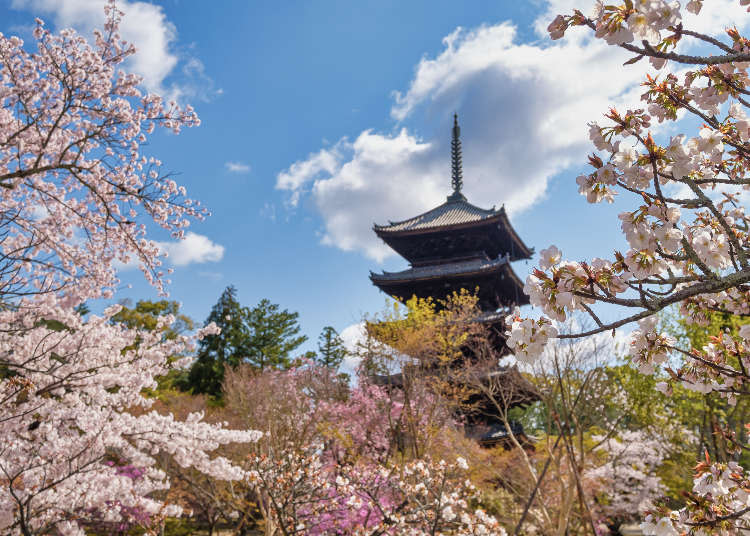
Formerly Japan's capital for over a millennium, Kyoto is full of famous temples, shrines, and places of note that appear in classic literature.
Many of these places are famous for seeing Kyoto cherry blossoms and are typically characterized by having weeping cherry trees and double-flowered cherry trees. Tourists are treated to the city's unique, luxurious annual blossom viewing when the trees reach full bloom in early April.
Here are ten locations carefully selected from among Kyoto's many famous cherry blossom sites, along with information on the best time for viewing and associated festivals for your reference when visiting the ancient capital.
1. Yodogawa Kasen Park: A masterpiece of riverside cherry blossom tunnels
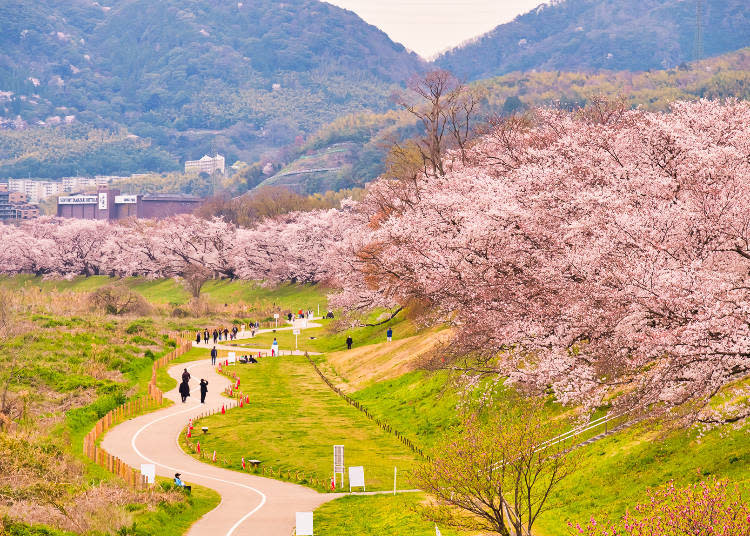
First-time visitors will often Tweet, "What an amazing place!"
Yodogawa Kasen Park is a national park covering a vast river area that straddles Kyoto and Osaka prefectures. The park's Sewaritei area in Yawata City is located on a 1.4 kilometer-long bank between the Uji and Kizu rivers, where they converge with the Katsura River to form the Yodo River.
Around 220 Yoshino cherry trees line the park's footpaths, making it a very popular Kyoto cherry blossom viewing destination.
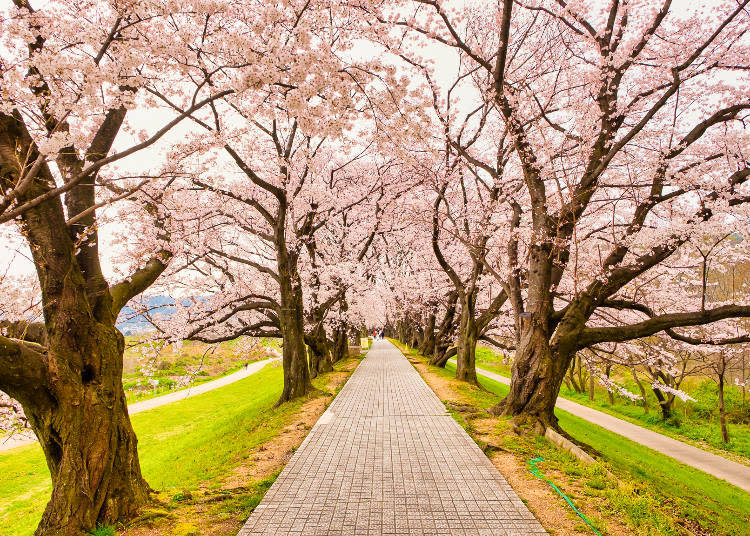
The nearly 1.4-kilometer cherry blossom tunnel
Located on a hill and situated about 25 meters above ground, the Sakura Deaikan observation tower overlooks the cherry blossom trees and the Uji and Kizu rivers.
On the outskirts of Kyoto, the park is a popular place to enjoy the beautiful river scenery, and its Sewaritei Sakura Festival draws as many as 450,000 people annually. The festival features plenty of stands selling beer and sake, and it's a vivacious event.

Locally known as "Sewaritei Sakura" ('Sewari-tei' means 'separation levee')
Peak viewing: Early April
Sewaritei Sakura Festival
・Venue: Yodogawa River Park Sewaritei Area
・Date: Late March to early April
・Admission: Free
・Phone: 075-633-5120 (Sakura Deaikan)
Yodogawa Kasen Koen Sewariteichiku
Yawatazaiouzizisaki, Yawata Shi, Kyoto Fu, 614-0000
Access: 10-minute walk from Keihan Electric Railway Iwashimizu Hachimangu Station
075-633-5120
Admission: Free
2. Ninnaji Temple: Late-blooming eye-level Omurozakura is a must-see

A place of worship famous for Kyoto's last-blooming cherry blossoms
Kinugasa, Hanazono, and Omuro in northwestern Kyoto are home to many aristocratic villas established during the imperial capital days, as well as major temples like Kinkakuji and Ryoanji.
One of the temples, Ninnaji, is the head temple of the Buddhist Shingon sect's Omuro school. The complex is magnificent with the impressive Niomon (temple gate), the elegant palace, the main hall, and the five-storied pagoda.
About 200 cherry trees are planted against the backdrop of these buildings, with the weeping cherry tree in front of the bell tower and the Yoshino cherry tree near the main hall as the most iconic.
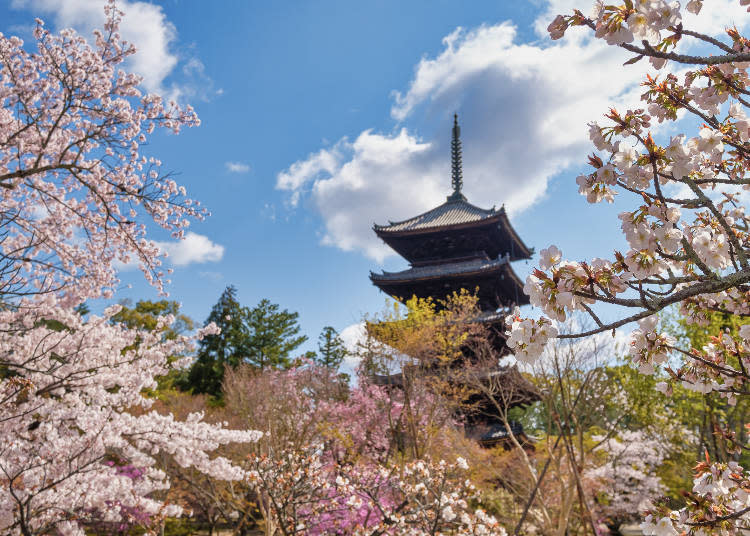
Omurozakura with the five-storied pagoda in the background is a popular sight to witness
Special attention is paid to the late-blooming (early to mid-April) cherry blossoms called Omurozakura, with a grove located west of the central gate.
During the Kyoto cherry blossom viewing period in the Edo period (1603-1867), it was praised as being as wonderful as Nara's Mt. Yoshino. The trees only reach a height of 2 to 3 meters, creating a unique landscape and making it one of Kyoto's most famous cherry blossom spots.

You can enjoy the cherry blossoms at eye level
Peak viewing: Early to mid-April
Omuro Flower Festival
・Venue: Ninnaji Temple Precincts
・Date: Late March to early May, 9:00 - 17:00 (subject to change)
・Admission: Adults 500 yen, high school students and younger free
・Phone: 075-461-1155 (Ninnaji Temple, Headquarters)
Ninna-ji Temple
33, Omuroouchi, Ukyo-ku, Kyoto-shi, Kyoto
Omuroninnaji
075-461-1155
3. Maruyama Park: Experience Kyoto's premier "Gion-no-Yozakura"

Famous for its Gion Shidarezakura (weeping cherry trees) and 680 trees in full bloom around the pond
Gion, located in the southeastern part of the city, is home to the Yasaka Gion Festival, the largest festival in Kyoto. Yasaka Shrine can also be found in this gorgeous area, as is Kyoto's oldest park, Maruyama Park, which sits between Yasaka Shrine and the Jodo sect's Chion-in temple.
The park is Kyoto's largest cherry blossom viewing area, with 680 trees. At the time of flowering, the whole park is transformed into a fantastic sea of cherry blossoms.

Gion Shidarezakura are in bloom until early April and the blossoms are exceptionally beautiful at night too
Standing in the park's center is a single white weeping cherry tree, known as "Hitoe Shiro Higan Shidarezakura." The site's original weeping cherry tree was a natural monument, but it withered and has been replaced by the current second-generation tree.
The giant tree with a trunk circumference of 2.8 meters, a height of 12 meters, and branches spreading out 10 meters was grown from a seed produced by the original tree. It's a popular Kyoto cherry blossom spot for visitors who come to gaze at the magnificent sakura tree.
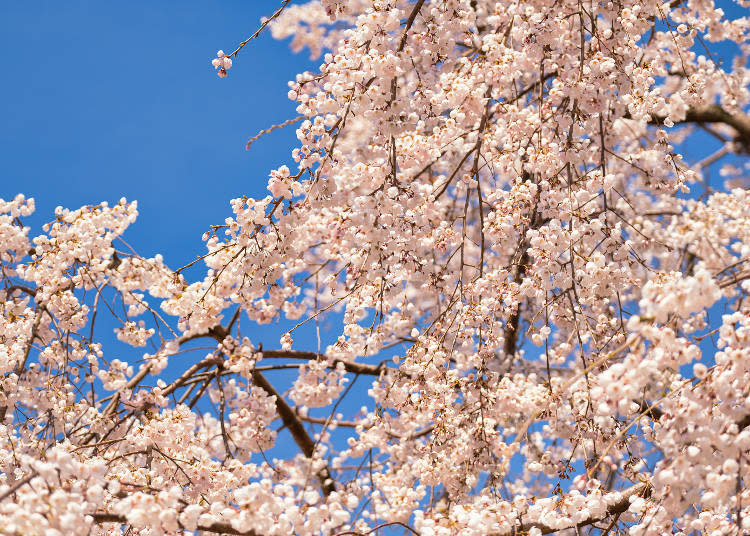
The weeping cherry tree is lit up from sunset to midnight when it is in full bloom every year (dates vary)
Peak viewing: Late March to early April
Maruyama Park
473, Maruyamacho, Higashiyama-ku, Kyoto-shi, Kyoto others
Gionshijo
075-561-1350
4. Daigoji Temple: Famous for its "Daigo of Flowers" blossoms
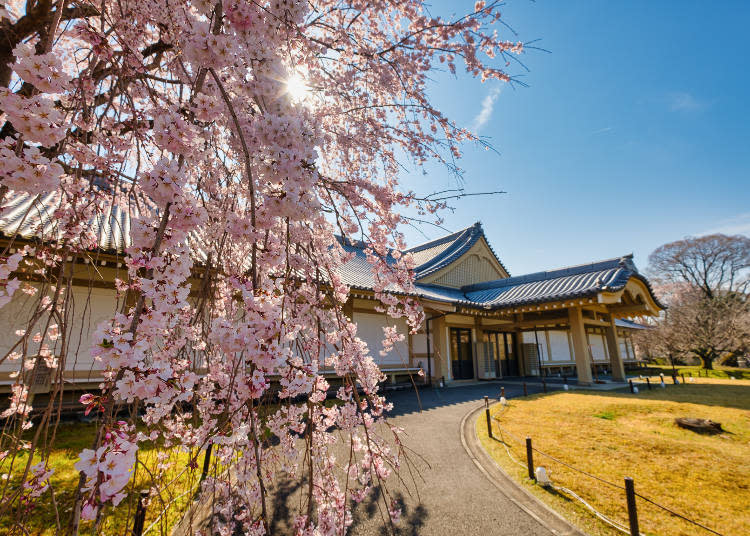
The long-blooming "Daigo of Flowers" variety loved by Toyotomi Hideyoshi
Vast Daigoji Temple, covering nearly seven square kilometers, is one of the best cherry blossom viewing spots in southern Kyoto and was the setting for Toyotomi Hideyoshi's "Daigo-no-Hanami" blossom party.
Here, various cherry blossoms bloom one after another over a period of about three weeks. A row of trees stretches from the main gate and a giant weeping cherry tree, which is said to be 180 years old, fills the sky near the Reihokan (museum), which houses national treasures.
The garden opposite the Reihokan is the place where the famous "Daigo no Hanami" took place and the benches are draped in scarlet felt to heighten the air of luxurious Kyoto cherry blossom viewing.

Don't miss the beautiful weeping cherry tree!
Near the five-storied pagoda – the oldest wooden building in Kyoto, completed in 951 – there are giant weeping cherry trees and Oyama cherry trees over 100 years old.
North Japanese hill cherry blossoms can be found near the Benten-do, which, along with the red hall, reflect in the pond, creating a beautiful landscape. From the Benten-do, take the trail to the mountaintop Kaisan-do for a beautiful view of mountainside blossoms and scenery that's otherworldly!
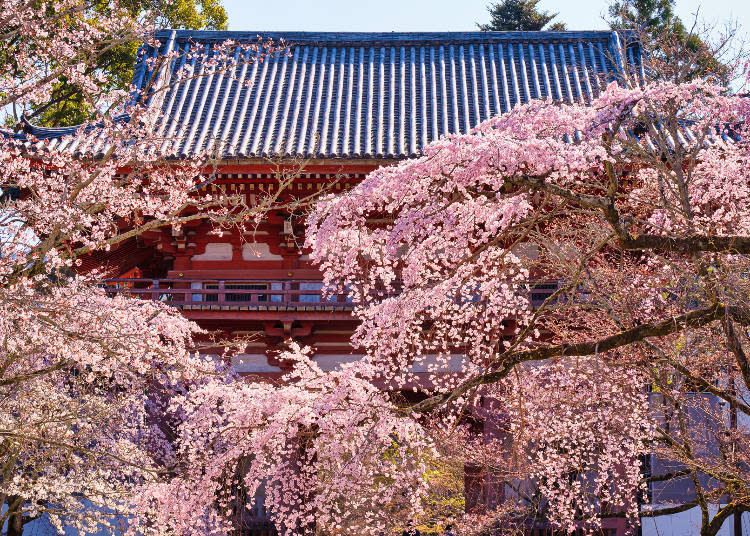
About 1,000 cherry trees are scattered across the vast grounds
Peak viewing: Late March to early April
Hotaiko Hanami Procession
・Venue: Daigoji Temple
・Date: 2nd Sunday of April 13:00 - 15:00
・Admission: Call for details
・Phone: 075-571-0002 (9:00 - 17:00)
Daigo-ji Temple
22, Daigohigashiojicho, Fushimi-ku, Kyoto-shi, Kyoto
Daigo
075-571-0002
5. Arashiyama: A magnificent view of Kyoto cherry blossoms overlooking Togetsukyo Bridge
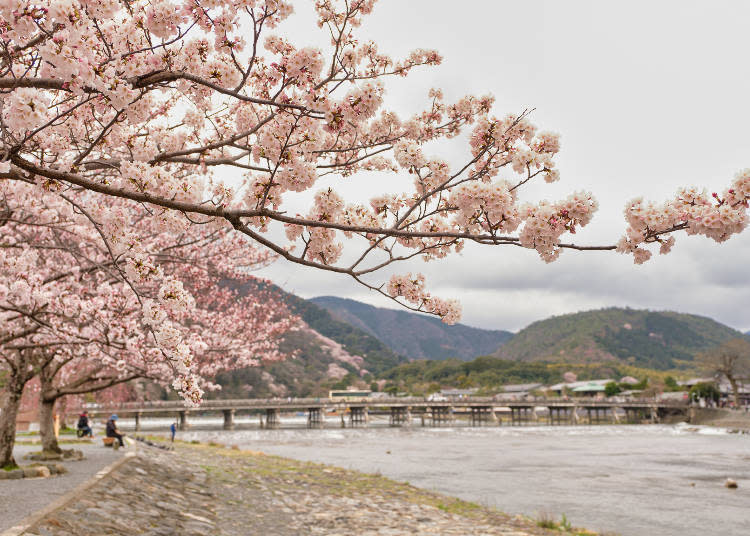
A great view of the Kyoto cherry blossoms along with the Togetsukyo Bridge and Katsura River
Arashiyama Gorge in western Kyoto city is a popular tourist area with many famous places. It is the setting for stories such as "The Tale of Genji" and "The Tale of the Heike."
The name "Arashiyama" is said to have originated from the "storm-like dance" of the spring cherry blossoms and autumn leaves. The sight of the Togetsukyo Bridge spanning the Oi River is representative of Arashiyama's scenery.
Formerly knowns as Kazuno River, it came to be called the "Oi River" when a large weir was constructed along its course. About 1,500 Yoshino cherry trees bloom around the Arashiyama area during cherry blossom season, with plentiful viewing spots.

Part of Arashiyama's charm is that you can enjoy cherry blossoms everywhere along the river
Of course, blossoms reflected on the surface of the water near Arashiyama Park and Togetsukyo Bridge are highlights. Still, there are many wild cherry trees near Osawa Pond and Hirosawa Pond in the north, offering a different atmosphere.
Okusaga, located northwest of Arashiyama, was once a place for sky burial, and Adashino Nenbutsuji Temple and its bamboo grove have a mysterious atmosphere. Although it really isn't, it's considered a "hidden" spot where about 60 cherry trees bloom.
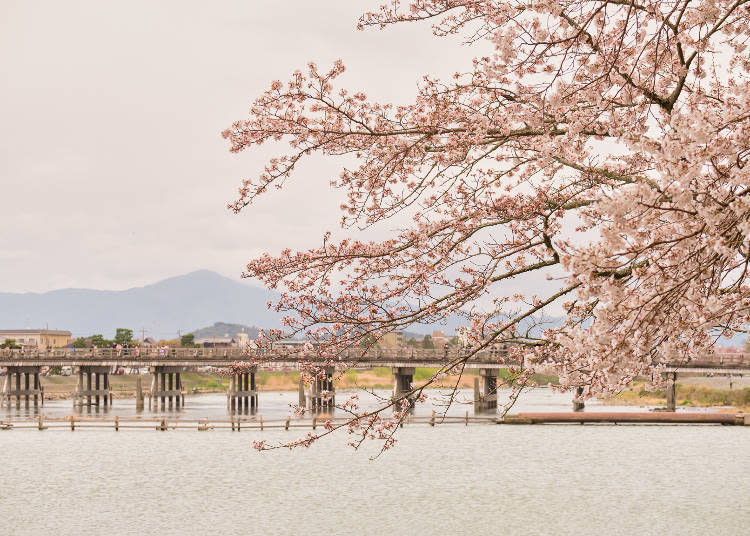
Scenery selected as one of the "100 Best Cherry Blossom Spots"
Peak viewing: Mid-March to late April
Arashiyama
Saganakanoshimacho,Ukyo Ward, Kyoto, 616-8383
Access: 5-minute walk from Hankyu Electric Railroad / Keifuku Electric Railroad
075-343-0548
Admission: Free
6. Heian Jingu Shrine: Fascinating Yaebeni Shidarezakura

Yaebeni Shidarezakura, depicted in literary works
Heian Jingu Shrine was built in 1895 in an area loved by influential cultural and literary figures, neighboring Jishoji/Ginkakuji, Kyoto University, and the National Museum of Modern Art, Kyoto.
The striking red shrine is a unique place where you can experience the thousand years of Heiankyo (The name of ancient Kyoto, meaning "tranquility and peace" and traditionally characterizing the era).
The shrine's garden is scenic and features a graceful pond, perfect for a garden stroll where Yae-beni Shidarezakura, which appear in the novel "Sasameyuki" by literary master Junichiro Tanizaki, bloom.

The sight of cherry blossoms and vermilion buildings is breathtakingly beautiful
In the garden, 300 cherry trees, including varieties such as Yae-beni Shidarezakura, Beni Shidarezakura, Somei Yoshino, Satozakura, Yamazakura, and Ukonzakura, grow. Along with the Yae-beni Shidarezakura, another must-see is the lone Yamazakura near the main hall (Daigokuden), called "Sakon no Sakura."
The tree's age is unknown, but it is a majestic, solitary tree that overwhelms the view. There are tea ceremonies and concerts during the Kyoto cherry blossom season, and visitors can also enjoy blossom viewing at night.

The vast strolling garden is designated as a national scenic location
Peak viewing: Early to mid-April
Heian Jingu Beni Shidare Concert
・Venue: East Garden / Villa
・Date: Early April 18:15 - 21:00 * Illuminated during the period
・Admission: Advance ticket 1,800 yen, same-day ticket 2,000 yen
・Phone: 075-241-6170 (Heian Jingu Beni Shidare Concert Secretariat)
Sakura Tea Ceremony
・Venue: "Choshintei" tea room
・Date: Early April 9:00 - 16:00
・Admission: 800 yen, separate Shinen garden admission 600 yen
・Phone: 075-761-0221 (Heian Jingu)
Heian-jingu Shrine
97, Okazakinishitennoucho, Sakyo-ku, Kyoto-shi, Kyoto
Higashiyama
075-761-0221
7. Kiyomizu Temple: See the sea of cherry blossom "clouds" from Kiyomizu Stage
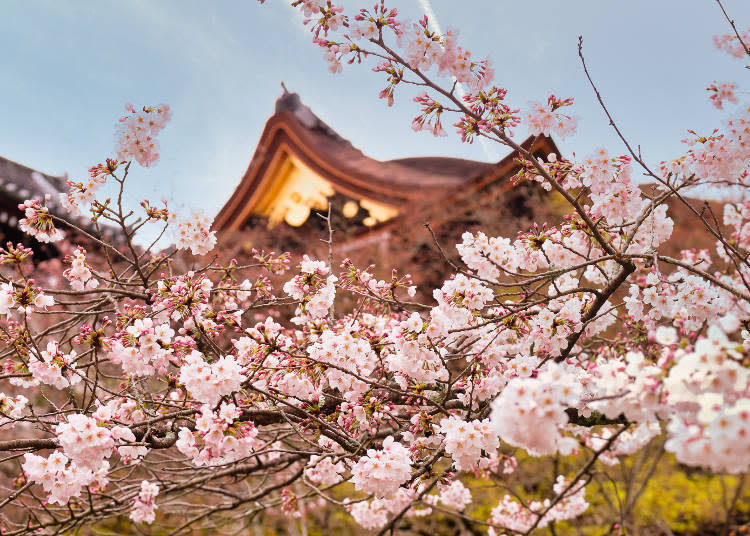
The ancient temple is a World Heritage Site symbolic of Japan
Kiyomizu-dera, known for its Kiyomizu Stage, is another of Kyoto's popular cherry blossom viewing venues. The stage provides an overlook of the city, and is a major tourist draw in all seasons.
Over the course of its long history, the temple has burned down multiple times, but was rebuilt each time. The large temple complex, representative of Kyoto, includes 30 temples across 13 hectares.

The sight of the three-storied pagoda and the cherry blossoms is one of Kiyomizu's highlights
Both the view from Kiyomizu Stage and the view of the Stage from Oku-no-in are superb. About 1,500 Yamazakura and Somei Yoshino cherry trees grow below the stage, creating a cloud-like sea of cherry blossoms. When illuminated for special night visitation, the atmosphere is fantastic.

During the special viewing period, the blossoms are lit up and you can enjoy them in a different light
Peak viewing: Early-mid April
Kiyomizu-dera Temple
1-294 Kiyomizu, Higashiyama-ku, Kyoto City, Kyoto Prefecture
Gionshijo
075-551-1234
8. Kyoto Botanical Gardens: A special place where you can see 160 kinds of cherry blossoms

There are many types of cherry blossoms, and you can enjoy blossom viewing for over a month
Kyoto Botanical Gardens was the first public botanical garden established in Japan, in 1924. It is a popular tourist destination where more than 12,000 kinds of plants grow.
There are many attractions, including a native forest that's full of local plants and flowers in all seasons and beautiful irises, but the cherry blossoms are especially fulfilling. With about 450 cherry trees from 160 varieties, it's almost like a living cherry blossom museum.
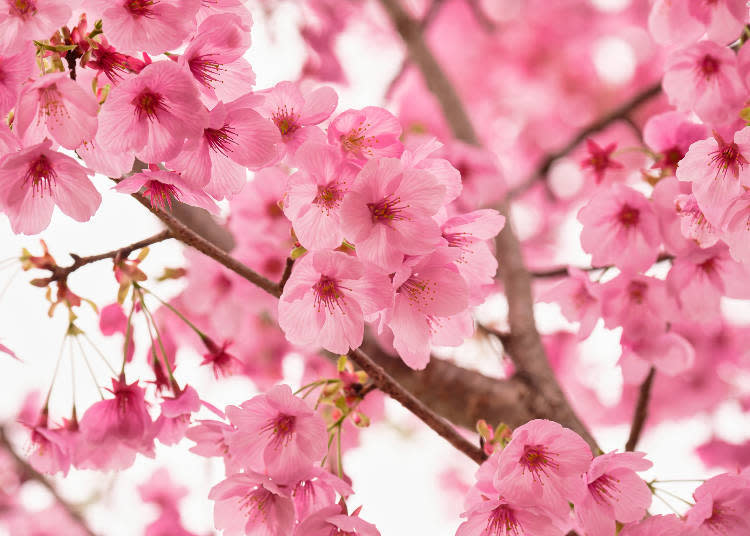
A variety of cherry blossoms called "sunlight" (Yoko) found in the garden park
From Kanhi-zakura in early March to Somei Yoshino and Yae-beni Shidarezakura in early April, and Kikuzakura in late April, various cherry blossoms continue to bloom against the backdrop of Mt. Hiei for over a month. The Kyoto Botanical Gardens are a great place to learn about the variety of cherry blossoms and deepen your understanding of cherry blossom culture.
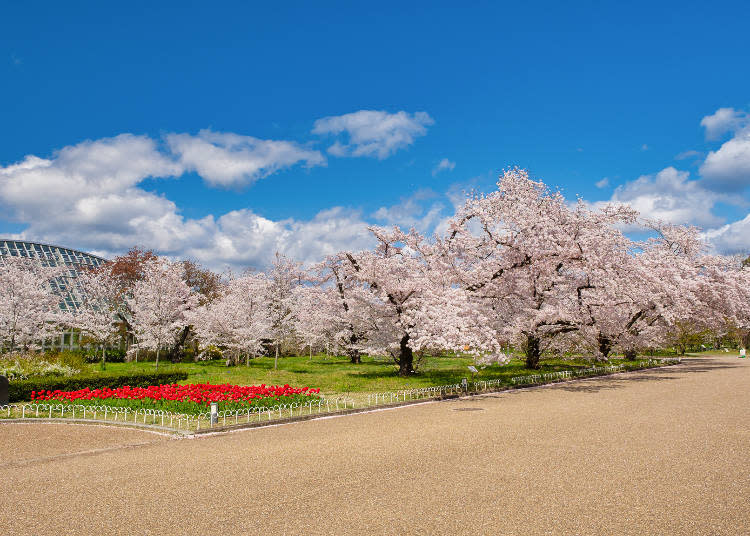
Only here can enjoy the combination of Yoshino cherry trees and red tulips
Peak viewing: Early March to late April
Koyto Botanical Gardens
Shimogamohangicho, Sakyo-ku, Kyoto-shi, Kyoto
Kitayama
075-701-0141
9. Keage Incline: Look at the blossoms as you walk the rails
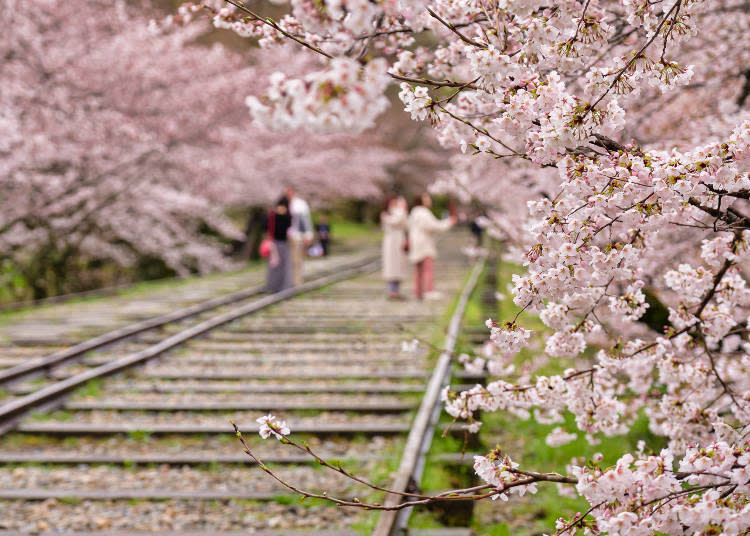
A popular Kyoto cherry blossom spot where you can walk along the railroad tracks to see the sakura
On the eastern side of Kyoto, an aqueduct was built to carry cargo from Lake Biwa to Kyoto and was used until 1948. Upon arrival in Kyoto's Keage area, boats were transferred to rails by means of a trolley system to complete their transit to the Nanzenji Temple Dock.
The incline and aqueduct have been preserved as industrial heritage sites, and in recent years have become tourist attractions.

Keage Tunnel: The unique scenery of modern ruins is also intriguing
Keage Incline is located near Nanzenji Temple and is the world's longest sloping railway with a total length of 582 meters. About 90 Yoshino and Yamazakura cherry trees flank the incline, making it perfect for cherry blossom photos as you traverse the rails.
Flowering season is in early April and a fountain near the former boat entrance serves as a memorial to the past liveliness of boat transportation amidst the unique scenery of modern ruins.
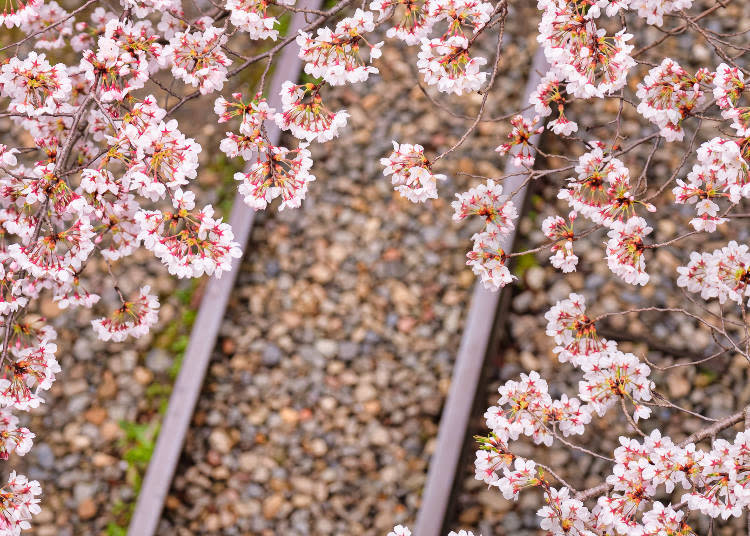
There is a height difference of about 36 meters from Lake Biwa Canal to the top of the steep slope
Peak viewing: Late March to early April
Keage Incline
Nanzenjifukuchicho, Sakyo-ku, Kyoto-shi, Kyoto
Keage
10. The Philosopher's Path: Hitome Senbon Yamazakura that paint the World Heritage site

The Philosopher's Path runs for about 2 kilometers along a canal flowing from Nyakuoji Bridge, just outside Kumano Nyakuoji Shrine to Ginkakuji intersection.
The path was made in 1890 along with the 3.3-kilometer canal, which is connected to the Keage Incline and is part of the Biwa Canal system. Philosophers who lived in the area would walk along the path, granting it its name.

The cherry blossoms bloom in sequence, beginning with the lower altitude trees
Japanese painter Hashimoto Kansetsu donated 300 Yoshino cherry trees for planting along the canal, which then grew to about 400 trees (Somei Yoshino, Oshimazakura, Yaezakura, weeping cherry blossoms, etc.) commonly known as the "Kansetsu Sakura."
You can enjoy the fresh beauty of Japanese spring as you take in the view of a series of small stone bridges and cherry blossoms that overhang the canal, as well as other flowers in bloom such as camellia, forsythia, Thunberg spiraea, and Japanese kerria.

Peak viewing: Late March to early April
The Yoshino Cherry Trees of the Philosopher’s Walk
Kyoto Prefecture Kyoto City Sakyo Ward Jodo Temple Ishibashi Town-Wakaoji Town
Kyoto
075-761-3863
So what do you think? Kyoto itself an excellent tourist destination with plenty of sights to appreciate, but if you visit during peak cherry blossom season, you'll be able to experience the full charm of the ancient city arrayed in vibrant cherry blossoms. Come visit!
Japan Cherry Blossom 2021 Forecast: When & Where To See Sakura in Japan
Book an unforgettable experience in Kyoto!
Kyoto Sagano Romantic Train, Arashiyama, Kiyomizudera &Fushimi Inari-taisha Day Tour
Arashiyama and Sagano Walking Food Tour


